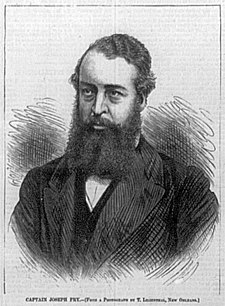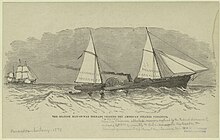| Joseph Fry | |
|---|---|
 | |
| Birth name | Joseph Fry |
| Born | June 14, 1826 Tampa Bay, Florida, United States |
| Died | November 7, 1873 Santiago de Cuba, Captaincy General of Cuba, Spanish Empire |
| Allegiance | |
| Service | |
| Rank | Captain |
| Battles / wars | |
Joseph Fry (June 14, 1826 – November 7, 1873) was a former U.S. Naval Officer, Confederate Civil War veteran, and commander of the ill-fated Virginius.
Early history
Joseph Fry was born on June 14, 1826, in Tampa Bay, Florida in the United States.
He decided early on to pursue a career in the Navy. He presented himself before John Tyler and asked to be sent to the United States Naval Academy. Fry graduated from the U.S. Naval Academy in Annapolis with honors.

He entered the United States Navy as a midshipman on September 15, 1841. As a naval officer, his first experience was acquired on the USS Missouri. During the Mexican–American War, the Siege of Veracruz in March 1847 was his first experience of naval warfare on board the USS Vixen. Upon his return home, he served on the vessels of the United States Coast and Geodetic Survey for several years.
By the 1860s, Fry had 15 years of experience as a captain in the US Navy before joining the Confederacy during the American Civil War. Within the Confederate Navy, the Confederate officer was elevated to the rank of commodore. In June 1862, he led the CSS Maurepas up the White River to oppose Union Navy advances, sinking the ship to close the channel. He was wounded during the retreat. Upon regaining his health, he was placed in command of the government blockade runner Eugenie.
Postbellum career
Fry was underemployed once that post vanished with the conclusion of the American Civil War in 1865. He entered the Cuban blockade service. During the late war, he made several blockading trips.
Ten Years' War
The Virginius Expedition

In July 1873, Captain Fry went to New York in hopes of finding employment with an ocean steamer. Upon meeting Cuban General Manuel de Quesada y Loynaz, he left New York on October 4, 1873, for Kingston, Jamaica, to take command of the Virginius as a blockade runner to aid the Cuban rebellion. The expedition was led under the direction of Mambí general Bernabé Varona and Jesús del Sol, W.A.C. Ryan, and Pedro de Céspedes were among the passengers. While in port, the Virginius was repaired and coaled at the expense of the Cubans. On October 24, 1873, the North American steamer left Kingston Harbor commanded by Captain Joseph Fry. The vessel was reported by the Spanish consul for its suspicious movements on the 30th of October. On October 31, the Spanish corvette Tornado dispatched by Spanish General Juan N. Burriel spotted Fry's vessel and pursued it, forcing Fry to flee back towards Jamaica. Fry instructed W.A.C Ryan and Varona to throw the heavy ammunition, horses, artillery, and gun carriages overboard to lighten the load of the steamer during the pursuit. 12 miles from British waters, Fry ignored a blank shot fired by the Tornado as a warning. A short while later, several shells whistled over the Virginius. At that point, Fry realized he could not escape and stopped the vessel between Cabo Cruz and Santiago, surrendering to the Tornado's captain. The ship was taken over by two armed boats that approached from the side. Presenting his documentation to the boarding officer, Captain Fry objected to the legality of his ship's seizure. The Tornado's commander revealed that the Virginius would have avoided capture if it had had another hour to enter a Jamaican port.
On November 1, 1873, the vessel, along with the leaders of the Cuban insurgency, crew members, and passengers, arrived at the port of Santiago de Cuba. In the following days, the crew was tried as pirates by a tribunal on board the Tornado and then confined to the city jail.
Death
On November 7, 1873, Joseph Fry was executed by firing squad along with 36 members of the Virginius crew.
References
- Britton, J. A. (2013). Cables, Crises, and the Press: The Geopolitics of the New Information System in the Americas, 1866–1903. United States: University of New Mexico Press.
- ^ "Life and adventures of Gen. W. A. C. Ryan, the Cuban martyr. Ryan, John Geo. Ed. New York, Chicago, Scully & Company, 1876". loc.gov. Retrieved 2024-06-14.
- ^ ""Life of Capt. Joseph Fry, the Cuban martyr. By Jeanie Mort Walker." In the digital collection The United States and its Territories, 1870 – 1925: The Age of Imperialism. – University of Michigan Library Digital Collections". name.umdl.umich.edu. Retrieved 2024-06-15.
- "The Captured Steamer Virginius – Newspapers.com™". newspapers.com. Retrieved 2024-06-14.
- "Yuba Dam. The Virginius. 1873 – Newspapers.com™". newspapers.com. Retrieved 2024-06-15.
- "The Executions in Cuba.; 1873 - Newspapers.com™". newspapers.com. Retrieved 2024-06-17.
- House Documents, Otherwise Publ. as Executive Documents: 13th Congress, 2d Session-49th Congress, 1st Session. (1874). United States: (n.p.).
- "First Martyrs in Cuba's Cause – Newspapers.com™". newspapers.com. Retrieved 2024-06-14.
- "The Virginius Massacre – Newspapers.com™". newspapers.com. Retrieved 2024-06-14.
- "The Capture of the Virginius – Newspapers.com™". newspapers.com. Retrieved 2024-06-14.
- "Capt. Fry.; 1873 – Newspapers.com™". newspapers.com. Retrieved 2024-06-15.